Aging
Nowitzki. Giggs. Raúl. Kidd. It’s been a hell of a sports season for some well-travelled veterans out there. Defying nature.
Peak, prime or whatever you want to call it, locating this pinnacle of a basketball career intrigues me and caused me to dig through Euroleague data from the past ten seasons.
In an open league with plenty of player movement, using an age-by-age comparison is not a noise-free undertaking. Don’t get irritated by odd exceptions, focus on the big picture.
Minutes

The trend is obvious. The most-used players in this league over a 10-year-period have been 27- and 28-year-olds. 25 and 31 have similar minutes, as have 24/32 and 23/33.
Scoring
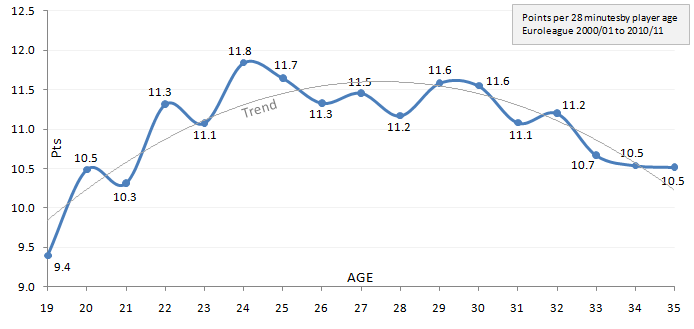
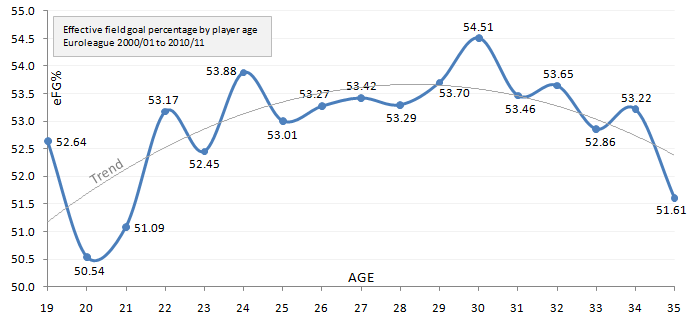
Scoring peaks in the 27/28 area. However, while scoring improves up to a relatively advanced age, other aspects are already in decline.
Long range shooting
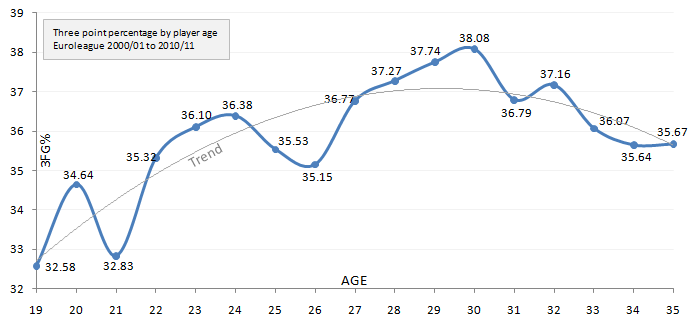
The average player is shooting excellent percentages until well in his thirties. 19 to 21 year olds have the bottom three career percentages, unsurprisingly.

3FGA/FGA is the percentage of field goal attempts being taken from three point range. This looks wild in the early years, but with the top six averages all in years 28 and later, the trend is clear: The average player takes more three pointers as he gets older.
Free throw shooting
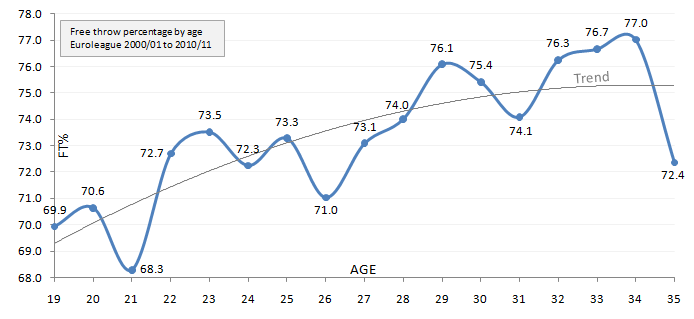
With no defense there to challenge the shot, top level free throw shooting can be performed longer than any other element in today’s game. 32 to 34 year olds are the top three in percentages.

Drawing shooting fouls to get there is another story. Trips to the line will decrease massively in the early thirties.
Rebounding
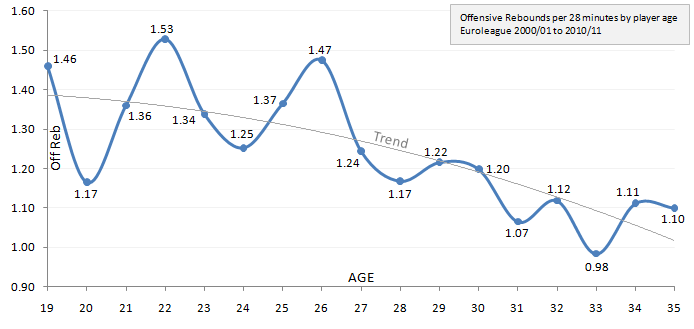
Remarkable. Offensive rebounding takes a massive hit after 26, standing in contrast to …
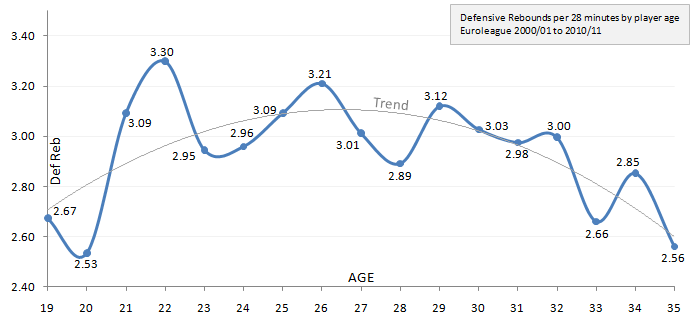
… defensive rebounding, which by cliché is more a matter of experience and technique (boxing out) than athleticism & power.
Passing
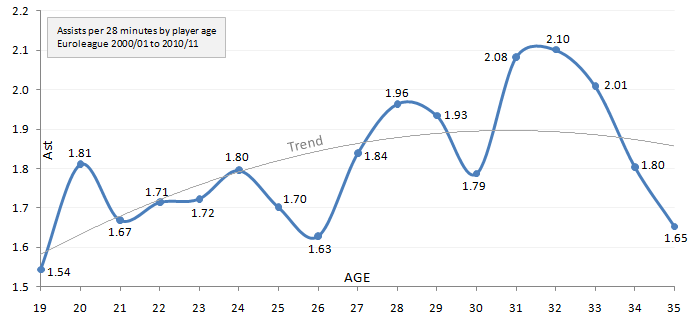
Assists production peaks in the early thirties, which makes us admire the talents of Ricky Rubio even more. The production of 21 to 24 year olds is comparable to the numbers of 34/35 year old veterans.
Shotblocking
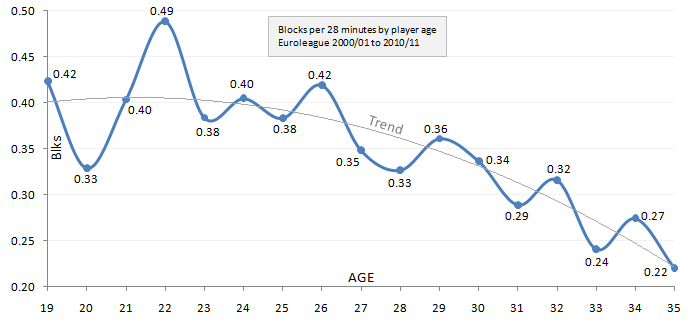
Shotblocking is very much comparable to offensive rebounding: by the time you reach 27, you are most likely already on a down trend. Should athleticism really decrease in the mid-twenties already? I say enjoy it while it lasts.
Turnovers
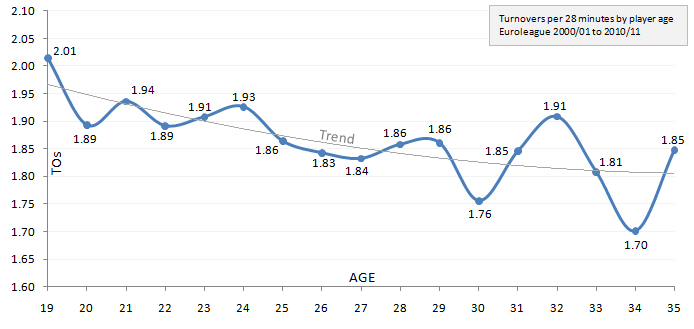
Young players are turning the ball over. There’s a learning curve and most likely a skill curve. More assists, fewer turnovers – numbers seem to back up the cliché that floor generals develop into such/reach their prime around 30.
Fouls
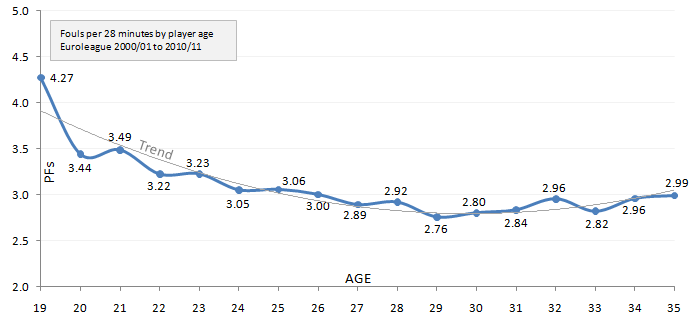
Jonas Valanciunas, who needs just 25 minutes for 5 fouls, is no exception. The average 19-year-old is committing 4.2 fouls per 28 minutes. A learning curve, see turnovers.
Efficiency
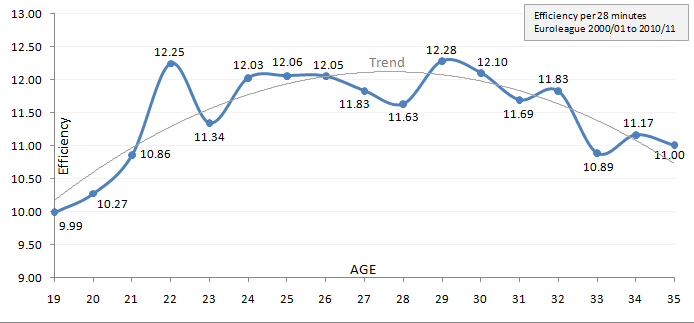
It is a plateau from 22 to 32. These are the years when players play their most productive (boxscore-wise) basketball. I would, based on these numbers, expect athletic abilities to decrease in the mid to late twenties and ball-IQ to peak in the early thirties.
Euroleague teams and how they fit in
I presented weighted age (1) a long time ago: Minute-weighted roster age. A player who doesn’t play, doesn’t weigh in. Using what we just learned, here are the scaled trend lines from the most basic categories, and the weighted age of all 24 teams from the 2010/11 Euroleague season. The number is just an average. Theoretically, a team could assign 100 minutes to 20 year olds and 100 minutes to 34 year olds in one game and come up with a weighted age of 27, when in fact all players are either much older or much younger.

Most teams were well in range of the peak years 26-29, some (Caja Laboral, Real Madrid) just reaching it, others (Panathinaikos, Montepaschi) slowly, slowly leaving. Cibona, at 22.1 weighted age, was hopelessly outmatched.
Notes from across the pond
- The average NBA finalist of the last 20 years had a weighted age of 28.59 years.
- Euroelague 2010/11 weighted age: 27.22 years. This is well on the level of the NBA’s weighted age in recent years.
Conclusion
Every athlete is different. There are true professionals who take care of their body and are able to perform into their late thirties. But there are also particular skills that translate well into the late thirties, important skills. Is the Mavericks’ success a pure coincidence? The Mavericks were top two among all playoff participants in three point shooting, free throw shooting and assists per minute. They had the highest 3FGA/FGA ratio of all playoff teams. It might be an exception for such an old team (weighted age: 31.02 years) to win the NBA championship, but the way they did it is not illogical.
Production in offensive rebounding and shotblocking decreases dramatically after the age of 26, that’s the most surprising discovery I am taking from these numbers. Drawing foul shots peaks well before the thirties. Heavily important factors like three point- and free throw shooting, as well as assists and turnovers, don’t.
(1) Not by any means claiming it is my invention
Pingback: Notes 20-08-2013 at in-the-game.org